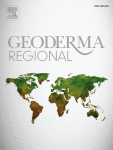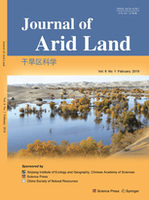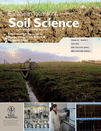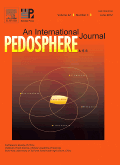
Geoderma Regional
Scope & Guideline
Innovating research at the intersection of agriculture and biology.
Introduction
Aims and Scopes
- Soil Health and Quality Assessment:
Research in this area focuses on developing and applying indicators for soil health and quality, assessing how various land use practices impact soil properties and ecosystem services. - Soil Carbon Dynamics and Climate Change:
Studies investigate soil organic carbon stocks and their changes in response to different land uses, climate conditions, and management practices, highlighting the role of soils in carbon sequestration and greenhouse gas emissions. - Digital Soil Mapping and Spatial Analysis:
The journal publishes research on the use of advanced technologies, such as remote sensing and machine learning, to create detailed soil maps and models that aid in understanding soil variability and predicting soil functions. - Soil Management Practices:
This includes research on practices such as conservation agriculture, agroforestry, and biochar application, focusing on their effects on soil properties, fertility, and sustainability. - Interactions Between Soil and Water:
Research emphasizes the relationship between soil properties and hydrological processes, including soil moisture retention, erosion, and water quality impacts. - Soil Biogeochemistry:
Investigations into the chemical and biological processes affecting soil nutrient cycling, enzyme activities, and microbial interactions, which are crucial for soil fertility and ecosystem health. - Land Use Change and Soil Degradation:
Research examines the impacts of land use transformations on soil structure, function, and health, with a focus on restoration and sustainable management practices.
Trending and Emerging
- Climate-Smart Agriculture and Soil Management:
There is a growing emphasis on research that integrates climate change adaptation strategies with soil management practices, highlighting the role of soils in sustainable agricultural systems. - Use of Machine Learning and Artificial Intelligence:
The application of machine learning techniques for soil property prediction and mapping has surged, reflecting advancements in technology and data analysis methods in soil science. - Agroecology and Sustainable Practices:
Research focusing on agroecological practices, such as permaculture and regenerative agriculture, is gaining traction, emphasizing sustainable land use and ecosystem health. - Soil-Water Interaction Studies:
An increase in publications exploring the interconnections between soil properties and water management practices, particularly in the context of drought and water scarcity, is evident. - Soil Restoration and Reclamation:
Research on the restoration of degraded soils, including techniques such as reforestation and the use of organic amendments, is becoming more prominent as environmental concerns grow. - Technological Innovations in Soil Sampling and Analysis:
Emerging technologies, such as drones and portable sensors, are being increasingly utilized for soil assessment, leading to more efficient and accurate soil management strategies.
Declining or Waning
- Heavy Metal Contamination Studies:
Research on soil contamination by heavy metals has decreased, possibly due to a shift towards broader studies on soil health and integrated pollution management. - Traditional Pedology and Soil Classification:
There is a noticeable decline in studies focused solely on traditional soil classification systems, as newer methodologies and technologies gain prominence. - Soil Erosion Studies:
While still important, the frequency of studies dedicated to soil erosion has waned, likely overshadowed by more integrated approaches addressing soil conservation within broader environmental contexts. - Historical Soil Studies:
Research focusing on historical land use and its effects on soil properties has decreased in favor of contemporary studies that address current challenges and management practices. - Soil Microbial Diversity Alone:
Although microbial interactions are still studied, there is a declining trend in research focusing exclusively on microbial diversity without linking it to functional outcomes or soil health.
Similar Journals

JOURNAL OF SOILS AND SEDIMENTS
Advancing the Science of Soil and Sediment DynamicsJOURNAL OF SOILS AND SEDIMENTS, published by SPRINGER HEIDELBERG, stands as a premier interdisciplinary platform dedicated to advancing the understanding of soil and sediment dynamics within the broader context of Earth sciences. With an impressive impact factor and a Q1 ranking in both Earth-Surface Processes and Stratigraphy, this journal not only reflects the high quality of research but also contributes significantly to the dialogue amongst researchers, professionals, and students in the field. The journal encompasses a wide spectrum of topics from sedimentology to soil science, making it essential reading for those involved in environmental management, agriculture, and geology. Access options are available to ensure that cutting-edge research is accessible to a global audience, reflecting the journal's commitment to fostering collaboration and innovation. As we converge towards 2024, JOURNAL OF SOILS AND SEDIMENTS aims to continue its role in shaping scientific inquiry and policy formulation concerning the vital roles of soils and sediments in ecological and geological systems.

Journal of Arid Land
Transforming research into policy for arid regions.Journal of Arid Land, published by SPRINGER HEIDELBERG, is a pivotal platform dedicated to advancing knowledge in the fields of Earth-Surface Processes, Management, Monitoring, Policy and Law, and Water Science and Technology. With an ISSN of 1674-6767 and an E-ISSN of 2194-7783, this journal stands out as a prominent source of scholarly research focusing on the unique challenges and opportunities of arid and semi-arid environments, particularly relevant in the context of global climate change. As of 2023, it holds a commendable Q2 ranking in several critical categories, underscoring its impact in environmental science and related disciplines. The journal, which has been in publication since 2009 and is set to continue through 2024, provides unrestricted access to high-quality research that sheds light on sustainable practices and effective policies. With its focus on arid lands, the Journal of Arid Land plays an essential role in fostering interdisciplinary dialogue among researchers, practitioners, and policymakers striving to address the pressing issues faced by these ecosystems.

EUROPEAN JOURNAL OF SOIL SCIENCE
Leading the Way in Soil Science Research and InnovationEUROPEAN JOURNAL OF SOIL SCIENCE, published by Wiley, stands as a leading platform in the field of soil science, recognized for its contributions to the understanding of soil ecology, management, and sustainability. With an impressive impact factor and a distinguished Q1 ranking in Soil Science, this journal has recently ranked 23rd out of 159 in its category on Scopus, placing it in the 85th percentile among its peers. Covering a wide array of topics as it converges into the future, from 1994 to 2024, the journal aims to disseminate groundbreaking research and innovative methodologies that address the pressing challenges of soil degradation and environmental sustainability in Europe and beyond. Although it is not an open access journal, the EUROPEAN JOURNAL OF SOIL SCIENCE remains a vital resource for researchers, professionals, and students seeking to deepen their understanding and explore the latest advancements in soil science.

PEDOSPHERE
Unveiling the Secrets Beneath Our FeetPEDOSPHERE, published by SCIENCE PRESS, is a leading journal in the field of Soil Science, holding a prestigious position in the Q1 category as per the latest evaluations, reflecting its high impact and relevance in the domain. Established in 1996, this journal is committed to advancing our understanding of soil-related processes and their interactions with various environmental components, providing a platform for innovative and high-quality research. With an impressive rank of #13 out of 159 in the Scopus classifications for Agricultural and Biological Sciences, PEDOSPHERE reaches the 92nd percentile, indicating its significance among scholarly publications. Although the journal operates under traditional access options, it remains an essential resource for researchers, professionals, and students keen on exploring the complexities of soil dynamics and sustainability. By bridging interdisciplinary methodologies and fostering collaboration, PEDOSPHERE plays a vital role in addressing global challenges related to soil management, conservation, and ecological balance.

Soil Systems
Championing Open Access Research in Soil SystemsSoil Systems, published by MDPI, is a premier open access journal dedicated to advancing the understanding of soil science and earth-surface processes. Launched in 2017, this journal has quickly established itself with a strong presence in the academic community, holding a prestigious Q1 ranking in both Earth-Surface Processes and Soil Science as of 2023. With an impressive Scopus rank in the top 20% of its categories, Soil Systems is an essential platform for disseminating groundbreaking research addressing the challenges and complexities of soil management, its ecological significance, and its role in sustainable development. The journal operates under an open access model since 2018, ensuring maximum visibility and accessibility for researchers, professionals, and students alike. Based in Switzerland, at ST ALBAN-ANLAGE 66, CH-4052 BASEL, Soil Systems encourages contributions that promote interdisciplinary collaboration, innovative methodologies, and the application of findings to real-world issues related to soil health and environmental sustainability.

Frontiers in Soil Science
Advancing knowledge for a sustainable future.Frontiers in Soil Science, published by FRONTIERS MEDIA SA in Switzerland, is an esteemed open-access journal dedicated to advancing our understanding of soil systems and their vital role in ecosystem functioning and sustainable agricultural practices. Since its inception in 2021, this journal has quickly established itself within the scientific community, boasting a 2023 Scopus Q2 ranking in Soil Science and a notable percentile of 41 among its peers. Researchers and practitioners in the field will find a wide array of original research, reviews, and contributions that address key topics such as soil health, carbon sequestration, and nutrient cycling. With a commitment to fostering collaboration and dissemination of knowledge, Frontiers in Soil Science serves as a vital resource for professionals, researchers, and students who aspire to innovate and lead in soil science research.

SOIL & TILLAGE RESEARCH
Advancing Soil Science for Sustainable FuturesSOIL & TILLAGE RESEARCH is a premier international journal dedicated to advancing the understanding of soil science and tillage practices through high-quality research and insightful reviews. Published by Elsevier and based in the Netherlands, this esteemed journal boasts impressive impact metrics, being ranked in the Q1 category across multiple domains including Agronomy and Crop Science, Earth-Surface Processes, and Soil Science, reflecting its pivotal role in the academic community. With an H-Index that underscores its citation impact and a Scopus ranking placing it in the top percentiles of its field, SOIL & TILLAGE RESEARCH serves as a vital resource for researchers and professionals focusing on sustainable agricultural practices, soil management, and environmental conservation. This journal provides a platform for open dialogue and dissemination of knowledge that shapes future research directions and policy-making in land use and sustainable agriculture.

CATENA
Connecting Scholars to Transform Earth-Surface UnderstandingCATENA is a distinguished academic journal published by Elsevier, focusing on the critical field of Earth-Surface Processes. With a solid foundation established in 1973, CATENA has continuously evolved, offering a platform for high-impact research and groundbreaking discoveries in geosciences. The journal holds an impressive Scopus rank of #8 out of 179 in its category, placing it in the top 5% of its field, which underscores its importance and influence among researchers and practitioners alike. While CATENA does not operate under an open access model, its commitment to disseminating essential findings is evident in its rigorous peer-review process and inclusion of diverse studies. Located in the Netherlands, CATENA not only serves as an essential resource for professionals and students but also contributes valuable insights that help address global environmental challenges.

SOIL SCIENCE SOCIETY OF AMERICA JOURNAL
Elevating Soil Science to New HeightsWelcome to the SOIL SCIENCE SOCIETY OF AMERICA JOURNAL, a premier publication in the field of soil science, published by WILEY. With a distinguished history dating back to 1976, this journal has consistently provided a platform for researchers to share innovative findings and insights into soil’s critical role in agricultural and ecological systems. Featuring an impressive Q1 category ranking in Soil Science and positioned within the top 25% of its field according to Scopus, this journal is recognized for its impactful contributions to advancing our understanding of soil dynamics. While not an open-access journal, it remains a valuable resource for academics and professionals alike, with distinguished articles that meet the highest scientific standards. As it enters its converged years from 1976 to 2024, the journal aims to continue shaping the future of soil research, offering valuable knowledge to students, researchers, and practitioners dedicated to sustainable land management and environmental preservation.

EURASIAN SOIL SCIENCE
Fostering collaboration to enhance soil sustainability.EURASIAN SOIL SCIENCE, published by PLEIADES PUBLISHING INC, is a premier journal dedicated to advancing knowledge in the fields of soil science and earth-surface processes. With an ISSN of 1064-2293 and an E-ISSN of 1556-195X, this journal has been a key resource for researchers and professionals from its inception in 1992 and continues to thrive as it converges toward 2024. Situated in the United States, EURASIAN SOIL SCIENCE has achieved notable recognition, attaining a Q2 ranking in both Earth-Surface Processes and Soil Science categories as of 2023. Its Scopus rankings further underscore its importance, with Earth and Planetary Sciences placing it at #81/179 and Agricultural and Biological Sciences ranking it at #80/159. Engaging a global audience, this journal publishes cutting-edge research articles, reviews, and case studies that address critical issues related to soil health, conservation, and management. Though currently not open access, the journal offers valuable insights and fosters collaboration among scientists and practitioners, underscoring its vital role in enhancing the understanding of soil dynamics and sustainability.